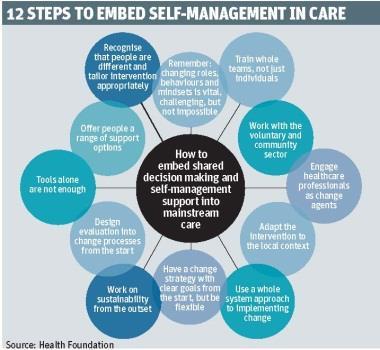Putting patients at the heart of care is easier said than done but lessons can be learned from some programmes to help embed service changes, say Suzanne Wood and Adrian Sieff

Smiling patient
Person centred care has emerged as a major policy theme across the UK. Strengthening people’s involvement in healthcare, and making services more responsive to their needs, is now a key goal in all four nations.
At its heart, person centred care is about a new relationship between health professionals and those using healthcare services. It is built on three principles:
- treating people with dignity, compassion and respect;
- ensuring care, support and treatment are both personalised and coordinated; and
- supporting people to recognise and develop their own strengths and abilities to enable them to live a fulfilling life.
The Health Foundation recently published a research report, Person Centred Care: From Ideas to Action, and a learning report,Ideas into Action: Person Centred Care in Practice, which synthesise current knowledge on shared decision making and self-management support, and how to make them an integral feature of healthcare.
‘Using decision aids as a patient resource without support potentially limits the extent to which patients can share decision making’
Shared decision making supports patients to make choices about services and often involves decision support materials that help individuals to weigh up their options.
Self-management support helps people develop the knowledge, skills and confidence to manage their own health.
These two options can improve patient wellbeing, satisfaction and patient’s knowledge of their condition and can lead to healthier lifestyles, improvements in clinical outcomes and changes in how services are used.

The research examined evidence from 11 large scale innovation programmes and identified a number of practical lessons for those looking to implement self-management support and shared decision making into mainstream care (see diagram). Some of these are highlighted below.
Tools alone are not enough
There are a range of tools and techniques available for use in the consultation and outside of it:
- agenda setting sheets can help people to think about what their goals are; brief decision aids, such as option grids, can help patients trade off between different benefits and risks;
- motivational interviewing can help clinicians support patients to work through ambivalence; and
- group based education can help provide patients with a support network alongside greater knowledge, skills and confidence.
However, tools alone are not enough: using decision aids as a patient resource without support not only potentially limits the extent to which patients can share decision making but also risks miscommunication and misunderstanding.
It is vital to embed tools and decision making support within a wider change in clinicians’ and patients’ roles and responsibilities. As our Making Good Decisions in Collaboration programme summarised: “skills trump tools; attitudes trump all.”
Training and support
Health professionals, alongside peer support workers and care navigators, have an important role to play in supporting patients to take a stronger role in their own care, with the emphasis being on collaboration. Training and support are vital to enable this to happen.
‘Training should focus on the team as a whole to foster collective responsibility’
In the MAGIC programme, it was found that a key barrier to health professionals taking part was the belief that that they were already sharing decision making with patients. Focusing on how they can be helped to improve their shared decision making successfully challenged clinicians’ perceptions and resulted in behaviour change.
Training should focus on the team as a whole to foster collective responsibility. The Whittington Trust saw particular success in its diabetes department and musculoskeletal pain service through this method.
The whole team was trained in delivering self-management support, which ensured the team shared a common purpose and meant that implementing service changes – such as introducing goal setting with patients prior to appointments – was more easily achieved.
Tailoring interventions
Tailoring care to specific groups has the capacity to make care more effective than when delivered through a generic approach. People may require different types of support depending on their condition, individual circumstances or their readiness and ability to be involved in their care.
Here are a few examples of when a tailored approach has had a tangible impact on healthcare outcomes:
- Care tailored by readiness: Across Yorkshire and the Humber renal patients were empowered through a programme of shared haemodialysis care. This allows patients receiving dialysis to take on as much involvement in administering their care as they feel comfortable with, from checking their blood pressure to setting up the dialysis machine, to inserting the dialysis needles.
- Care tailored for conditions: At University Hospital Southampton Foundation Trust, self-management support has been introduced as an essential component of follow-up care for patients with testicular and colorectal cancer, helping to identify care pathways more effectively.
- Care tailored to circumstance: An example of tailoring care to the needs of local communities came from a Tower Hamlets GP practice, which used Bengali storytelling groups to introduce patients to their diabetes results letter.
Building local ownership
Services are likely to be more receptive when they are enabled and supported – rather than directed – to change.
Local ownership is easier when programme aims and local priorities align. For example, the Year of Care in Diabetes programme emphasised the benefits for patients and health professionals of local ownership and decentralisation. Patient needs and goals were identified during care planning.
Developing the programme was left in the hands of the pilot sites, guided by five questions to answer and explore. While this was challenging, it also increased local buy-in and ongoing commitment.
Use a whole system approach, step by step
Change needs to be implemented at every level to make care more person centred. However, it is likely to be more successful if implementation takes place gradually, rather than attempting wholesale change all at once. Starting small in one clinical area and building on achievements may be most successful.
“Have a robust change strategy in place from the start, with clear goals but flexible implementation”
Have a robust change strategy in place from the start, with clear goals but flexible implementation, and consider sustainability from the outset. Shared decision making and self-management support need to be integrated into routine systems and processes.
The Health Foundation’s Co-creating Health programme included three elements:
- a self-management (group education) programme for people living with long term conditions;
- a practitioner development programme for health service staff; and
- a quality improvement element to help changes in service design support self-management, such as thechanging IT systems.
It was evaluated after the first phase, before implementing the second phase, which allowed important lessons to be learnt to help teams looking to spread the approach successfully to new clinical areas.
Work with the voluntary and community sector
It’s not all down to health professionals. A number of the programmes reviewed have demonstrated the power of communities in supporting the implementation of person centred care.
A good example of this was a project delivered as part of Nesta’s People Powered Health programme, which developed a model of social prescribing to integrate care and support planning processes in general practice with community based services and sources of support.
‘The potential for person centred care to transform the nature of healthcare delivery in this country is enormous’
Social “prescribing” supports GPs to refer and encourage people to take up activities instead of, or alongside, their medical prescription. This could include going to the gym, joining a reading group or taking up a hobby.
By developing a model to meet the range of needs of patients with long term conditions, the project has tried to move away from a disease specific view of long term conditions.
The potential for person centred care to transform the nature of healthcare delivery in this country is enormous.
Like all complex changes in healthcare, embedding approaches to person centred care – including self-management support and shared decision making – into mainstream services will take time and requires a unified and committed approach from health professionals, patients, health services and the voluntary and community sector.
Changing roles, behaviours and mindsets is vital, challenging and possible.
Suzanne Wood is policy manager and Adrian Sieff is assistant director at the Health Foundation



























No comments yet